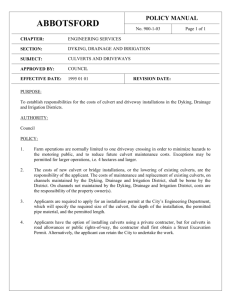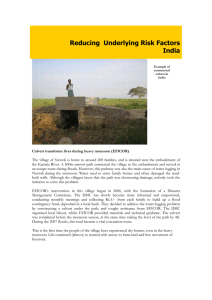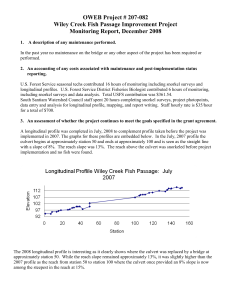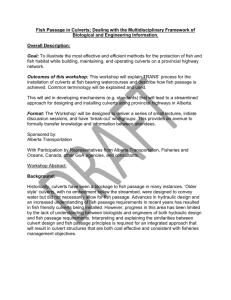CULVERT CRITERIA FOR FISH PASSAGE
advertisement
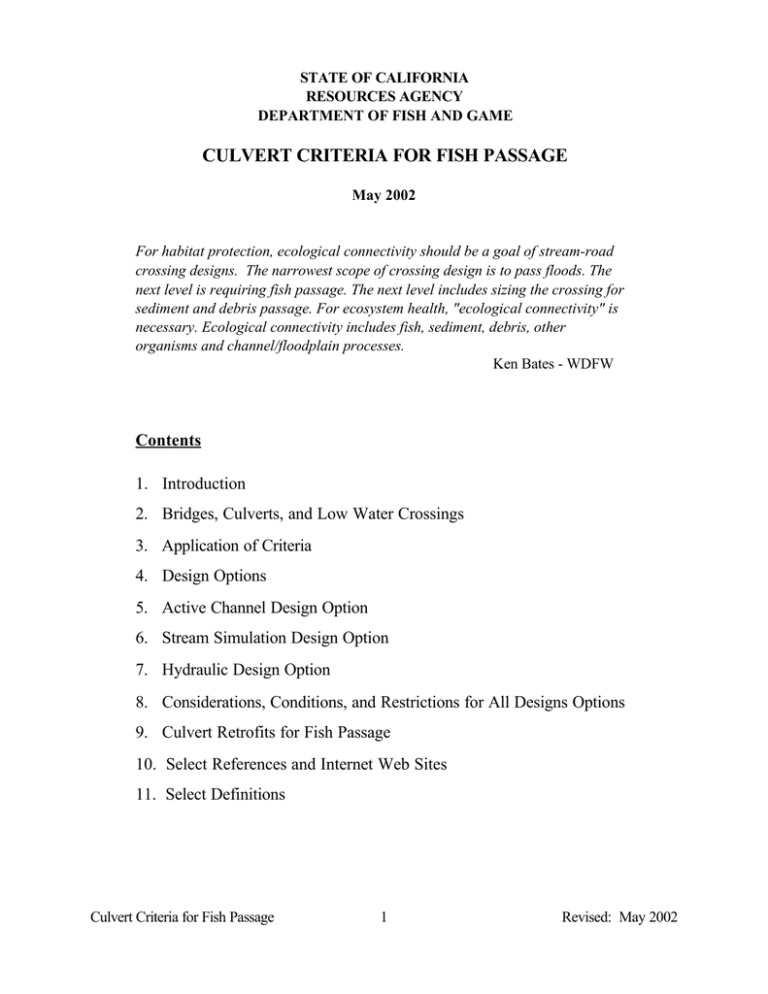
STATE OF CALIFORNIA RESOURCES AGENCY DEPARTMENT OF FISH AND GAME CULVERT CRITERIA FOR FISH PASSAGE May 2002 For habitat protection, ecological connectivity should be a goal of stream-road crossing designs. The narrowest scope of crossing design is to pass floods. The next level is requiring fish passage. The next level includes sizing the crossing for sediment and debris passage. For ecosystem health, "ecological connectivity" is necessary. Ecological connectivity includes fish, sediment, debris, other organisms and channel/floodplain processes. Ken Bates - WDFW Contents 1. Introduction 2. Bridges, Culverts, and Low Water Crossings 3. Application of Criteria 4. Design Options 5. Active Channel Design Option 6. Stream Simulation Design Option 7. Hydraulic Design Option 8. Considerations, Conditions, and Restrictions for All Designs Options 9. Culvert Retrofits for Fish Passage 10. Select References and Internet Web Sites 11. Select Definitions Culvert Criteria for Fish Passage 1 Revised: May 2002 1. Introduction The following criteria have been adopted by the California Department of Fish and Game (CDFG) to provide for upstream fish passage at culverts. This is not a culvert design manual, rather it is supplemental criteria to be used by qualified professionals for the design of culverts that meet both hydraulic and fish passage objectives while minimizing impacts to the adjacent aquatic and riparian resources. The objective of these criteria is to provide unimpaired fish passage with a goal of providing ecological connectivity. Previous versions of the CDFG Culvert Criteria were based on hydraulic design of culverts to match the swimming performance of adult anadromous salmonids. This revision of the criteria has been expanded to include considerations for juvenile anadromous salmonids, non-anadromous salmonids, native non-salmonids, and non-native fish. While criteria are still included for the Hydraulic Design Option, additional criteria have been added for two new design options that are based on the principles of ecological connectivity. The two additional design methods are the Active Channel Option and the Stream Simulation Option. The criteria contained in this document are based on the works of several organizations including state and federal agencies, universities, private organizations and consulting professionals. These criteria are intended to be consistent with the National Marine Fisheries Service, Southwest Region (NMFS­ SWR) Guidelines for Salmonid Passage at Stream Crossings, as well as being in general agreement with Oregon and Washington Departments of Fish and Wildlife culvert criteria for fish passage. This document is considered a Work in Progress and will be revised as new information warrants. Variances from these criteria, including the use of other design methodologies for fish passage, may be granted with the written approval of the Department of Fish and Game. At a minimum, the rationale for the variance must be described and justified in the request. Evaluation and monitoring may be required as a condition of any variance, to ensure that the requested variance does not result in a reduced level of protection for the aquatic resources. 2. Bridges, Culverts, and Low Water Crossings The Caltrans Highway Design Manual defines a culvert as “A closed conduit which allows water to pass under a highway,” and in general, has a single span of less than 6.1 meters (20 feet) or multiple spans totaling less than 6.1 meters. For the purpose of fish passage, the distinction between bridge, culvert or low water crossing is not as important as the effect the structure has on the form and function of the stream. To this end, these criteria conceptually apply to bridges and low water crossings, as well as culverts. Culvert Criteria for Fish Passage 2 Revised: May 2002 The primary factors that determine the extent to which fish passage will be impacted by the construction of a crossing are: 1) the degree of constriction the crossing has on the stream channel; 2) the degree to which the streambed is allowed to adjust vertically; 3) the length of stream channel impacted by the crossing, and; 4) the degree to which the stream velocity has been increased by the crossing. For unimpaired fish passage it is desirable to have a crossing that is a large percentage of the channel bankfull width, allows for a natural variation in bed elevation, and provides bed and bank roughness similar to the upstream and downstream channel. In general, bridges are preferred over culverts because they typically do not constrict a stream channel to as great a degree as culverts and usually allow for vertical movement of the streambed. Bottomless culverts may provide a good alternative for fish passage where foundation conditions allow their construction and width criteria can be met. In all cases, the vertical and lateral stability of the stream channel should be taken into consideration when designing a crossing. 3. Application of Criteria These criteria are intended to apply to new and replacement culverts where fish passage is legally mandated or is otherwise important to the life histories of the fish and wildlife that utilize the stream and riparian corridor. Not all stream crossings may be required to provide upstream fish passage, and of those that do, some may only require passage for specific species and age classes of fish. Where existing culverts are being modified or retrofitted to improve fish passage, the Hydraulic Design Option criteria should be the design objective for the improvements. However, it is acknowledged that the conditions that cause an existing culvert to impair fish passage may also limit the remedies for fish passage improvement. Therefore, short of culvert replacement, the Hydraulic Design Option criteria should be the goal for improvement and not the required design threshold. To determine the biological considerations and applicable criteria for a particular culvert site, the project sponsors should contact the Department of Fish and Game, the National Marine Fisheries Service (for projects in marine and anadromous waters) and the U.S. Fish and Wildlife Service (for projects in anadromous and fresh waters) for guidance. It is the responsibility of the project sponsor to obtain the most current version of the culvert criteria for fish passage. Copies of the current criteria are available from the Department of Fish and Game through the appropriate Regional office, which should be the first point of contact for any stream crossing project. Addresses and phone numbers for the California Department of Fish and Game Regional Offices are shown in Table 1. Culvert Criteria for Fish Passage 3 Revised: May 2002 California Dept of Fish and Game Regional Offices Region Address Phone Number Northern California ­ North Coast Region 601 Locust Street Redding, CA 96001 (530) 225-2300 Sacramento Valley ­ Central Sierra Region 1701 Nimbus Drive Rancho Cordova, CA 95670 (916) 358-2900. Central Coast Region 7329 Silverado Trail P.O. Box 47 Yountville CA 94599 (707) 944-5500 San Joaquin ValleySouthern Sierra Region 1234 E. Shaw Avenue Fresno, CA 93710 (559) 243-4005 x151 South Coast Region 4649 Viewridge Avenue San Diego, CA 92123 (858) 467-4200. Eastern Sierra ­ Inland Deserts Region 4775 Bird Farm Road Chino Hills, CA 91709 (909) 597-9823. Table 1 4. Design Options All culverts should be designed to meet appropriate hydraulic capacity and structural integrity criteria. In addition, where fish passage is required, the culvert shall be designed to meet the criteria of the Active Channel Design Option, Stream Simulation Design Option or the Hydraulic Design Option for Upstream Fish Passage. The suitability of each design option is shown in Table 2. Culvert Criteria for Fish Passage 4 Revised: May 2002 Allowable Design Options Active Channel Design Option (Section 5) or Stream Simulation Design Option (Section 6) Fish Passage Requirement Hydraulic Design Option For Upstream Fish Passage (Section 7) Adult Anadromous Salmonids X X Adult Non-Anadromous Salmonids X X Juvenile Salmonids X X Native Non-Salmonids X Non-Native Species X Conditional based on species swimming data Fish Passage Not Required X Hydraulic Capacity & Structural Integrity X Table 2 5. Active Channel Design Option The Active Channel Design Option is a simplified design method that is intended to size a crossing sufficiently large and embedded deep enough into the channel to allow the natural movement of bedload and formation of a stable streambed inside the culvert. Determination of the high and low fish passage design flows, water velocity, and water depth is not required for this option since the stream hydraulic characteristics within the culvert are intended to mimic the stream conditions upstream and downstream of the crossing. The Active Channel Design Option is suitable for the following conditions: • • • • New and replacement culvert installations Simple installations with channel slopes less than 3% Short culvert length (less than 100 feet) Passage required for all fish Culvert Setting & Dimensions - Figure 1 • Culvert Width - The minimum culvert width shall be equal to, or greater than, 1.5 times the active channel width. • Culvert Slope - The culvert shall be placed level (0% slope). Culvert Criteria for Fish Passage 5 Revised: May 2002 • Embedment - The bottom of the culvert shall be buried into the streambed not less than 20% of the culvert height at the outlet and not more than 40% of the culvert height at the inlet. Embedment does not apply to bottomless culverts. See Section 8 for additional considerations, conditions, and restrictions for all designs options. Figure 1 - Active Channel Design Option 6. Stream Simulation Design Option The Stream Simulation Design Option is a design process that is intended to mimic the natural stream processes within a culvert. Fish passage, sediment transport, flood and debris conveyance within the crossing are intended to function as they would in a natural channel. Determination of the high and low fish passage design flows, water velocity, and water depth is not required for this options since the stream hydraulic characteristics within the culvert are designed to mimic the stream conditions upstream and downstream of the crossing. Culvert Criteria for Fish Passage 6 Revised: May 2002 Stream simulation crossings are sized as wide, or wider than, the bankfull channel and the bed inside the culvert is sloped at a gradient similar to that of the adjacent stream reach. These crossings are filled with a streambed mixture that is resistant to erosion and is unlikely to change grade, unless specifically designed to do so. Stream simulation crossings require a greater level of information on hydrology and topography and a higher level of engineering expertise than the Active Channel Design Option. The Stream Simulation Design Option is suitable for the following conditions: • • • • • New and replacement culvert installations Complex installations with channel slopes less than 6% Moderate to long culvert length (greater than 100 feet) Passage required for all fish Ecological connectivity desired Culvert Setting & Dimensions - Figure 2 • Culvert Width - The minimum culvert width shall be equal to, or greater than, the bankfull channel width. The minimum culvert width shall not be less than 6 feet. • Culvert Slope - The culvert slope shall approximate the slope of the stream through the reach in which it is being placed. The maximum slope shall not exceed 6%. • Embedment - The bottom of the culvert shall be buried into the streambed not less than 30% and not more than 50% of the culvert height. Embedment does not apply to bottomless culverts. • Substrate Configuration and Stability • Culverts with slopes greater than 3% shall have the bed inside the culvert arranged into a series of step-pools with the drop at each step not exceeding the limits shown in Table 7. • Smooth walled culverts with slopes greater than 3% may require bed retention sills within the culvert to maintain the bed stability under elevated flows. • The gradation of the native streambed material or engineered fill within the culvert shall address stability at high flows and shall be well graded to minimize interstitial flow through the stream bed material. See Section 8 for additional considerations, conditions, and restrictions for all designs options. Culvert Criteria for Fish Passage 7 Revised: May 2002 Figure 2 - Stream Simulation Design Option 7. Hydraulic Design Option The Hydraulic Design Option is a design process that matches the hydraulic performance of a culvert with the swimming abilities of a target species and age class of fish. This method targets distinct species of fish and, therefore, does not account for ecosystem requirements of non-target species. There can be significant errors associated with estimation of hydrology and fish swimming speeds that are mitigated by making conservative assumptions in the design process. Determination of the high and low fish passage design flows, water velocity, and water depth are required for this option. The Hydraulic Design Option requires hydrologic data analysis, open channel flow hydraulic calculations and information on the swimming ability and behavior of the target group of fish. This design option can be applied to the design of new and replacement culverts and can be used to evaluate the effectiveness of retrofits for existing culverts. Culvert Criteria for Fish Passage 8 Revised: May 2002 The Hydraulic Design Option is suitable for the following conditions: • • • • • • New, replacement, and retrofit culvert installations Low to moderate channel slopes (less than 3%) Active Channel Design or Stream Simulation Options is not physically feasible Swimming ability and behavior of target species of fish is known Ecological connectivity not required Evaluation of proposed improvements to existing culverts Hydrology • High Design Flow for Fish Passage - The high design flow for fish passage is used to determine the maximum water velocity within the culvert. Where flow duration data is available or can be synthesized, use the values for Percent Annual Exceedance Flow shown in Table 3. If flow duration data is not available the values shown for Percentage of 2-yr Recurrence Interval Flow may be used as an alternative. High Design Flow for Fish Passage Percent Annual Exceedance Flow Percentage of 2-yr Recurrence Interval Flow Adult Anadromous Salmonids 1% 50% Adult Non-Anadromous Salmonids 5% 30% Juvenile Salmonids 10% 10% Native Non-Salmonids 5% 30% Non-Native Species 10% 10% Species/Life Stage Table 3 • Low Design Flow for Fish Passage - The low design flow for fish passage is used to determine the minimum depth of water within a culvert. Where flow duration data is available or can be synthesized, use the values for Percent Annual Exceedance Flow shown in Table 4. If the Percent Annual Exceedance Flow is determined to be less than the Alternate Minimum Flow, use the Alternate Minimum Flow. If flow duration data is not available the values shown for Alternate Minimum Flow may be used. Culvert Criteria for Fish Passage 9 Revised: May 2002 Low Design Flow for Fish Passage Percent Annual Exceedance Flow Alternate Minimum Flow (cfs) Adult Anadromous Salmonids 50% 3 Adult Non-Anadromous Salmonids 90% 2 Juvenile Salmonids 95% 1 Native Non-Salmonids 90% 1 Non-Native Species 90% 1 Species/Lifestage Table 4 Hydraulics • Maximum Average Water Velocity in Culvert (At high design flow) - Where fish passage is required the average water velocity within the culvert shall not exceed the values shown in Tables 5 & 6. • Minimum Water Depth in Culvert (At Low Design Flow) - Where fish passage is required the minimum water depth within the culvert shall not be less than the values shown in Tables 5. Maximum Average Water Velocity and Minimum Depth of Flow Maximum Average Water Velocity (fps) Minimum Flow Depth (ft) Adult Anadromous Salmonids See Table 6 1.0 Adult Non-Anadromous Salmonids See Table 6 0.67 1 0.5 Species/Lifestage Juvenile Salmonids Native Non-Salmonids Non-Native Species Culvert Criteria for Fish Passage Species specific swimming performance data is required for the use of the hydraulic design option for non-salmonids. Hydraulic design is not allowed for these species without this data. Table 5 10 Revised: May 2002 Culvert Length vs Maximum Average Water Velocity for Adult Salmonids Culvert Length (ft) Adult Non-Anadromous Salmonids (fps) Adult Anadromous Salmonids (fps) <60 4 6 60-100 4 5 100-200 3 4 200-300 2 3 >300 2 2 Table 6 • Maximum Outlet Drop - Hydraulic drops between the water surface in the culvert to the pool below the culvert should be avoided for all cases. Where fish passage is required and a hydraulic drop is unavoidable, it’s magnitude should be evaluated for both high design flow and low design flow and shall not exceed the values shown in Table 7. If a hydraulic drop occurs at the culvert outlet, a jump pool of at least 2 feet in depth shall be provided. Maximum Drop at Culvert Outlet Species/Lifestage Maximum Drop (ft) Adult Anadromous Salmonids 1 Adult Non-Anadromous Salmonids 1 Juvenile Salmonids Native Non-Salmonids Non-Native Species Culvert Criteria for Fish Passage 0.5 Where fish passage is required for native non-salmonids no hydraulic drop shall be allowed at the culvert outlet unless data is presented which will establish the leaping ability and leaping behavior of the target species of fish. Table 7 11 Revised: May 2002 • Hydraulic Controls - Hydraulic controls (e.g. boulder weirs, log sills, etc.) in the channel upstream and/or downstream of a crossing can be used to provide a continuous low flow path through the crossing and stream reach. They can be used to facilitate fish passage by establishing the following desirable conditions: • • • • Control depth and water velocity within the crossing Concentrate low flows Provide resting pools upstream and downstream of the crossing Control erosion of the streambed and banks • Baffles and Weirs - Baffles or weirs shall not be used in the design of new or replacement culverts in order to meet the hydraulic design criteria. • Adverse Hydraulic Conditions - The following hydraulic conditions are generally considered to be detrimental to efficient fish passage and should be avoided. The degree to which they impede fish passage depends upon the magnitude of the condition. Crossings designed by the Hydraulic Design Option should be evaluated for the following conditions at high design flow for fish passage: • • • • Super critical flow Hydraulic jumps Highly turbulent conditions Abrupt changes in water surface elevation at inlet and outlet Culvert Setting & Dimensions • Culvert Width - The minimum culvert width shall be 3 feet. • Culvert Slope - The culvert slope shall not exceed the slope of the stream through the reach in which the crossing is being placed. If embedment of the culvert is not possible, the maximum slope shall not exceed 0.5%. • Embedment - Where physically possible, the bottom of the culvert shall be buried into the streambed a minimum of 20% of the height of the culvert below the elevation of the tailwater control point downstream of the culvert. The minimum embedment should be at least 1 foot. Where physical conditions preclude embedment, the hydraulic drop at the outlet of a culvert shall not exceed the limits specified above. See Section 8 for additional considerations, conditions, and restrictions for all designs options. Culvert Criteria for Fish Passage 12 Revised: May 2002 8. Considerations, Conditions, and Restrictions for All Designs Options • Anadromous Salmonid Spawning Areas - The hydraulic design method shall not be used for new or replacement culverts in anadromous salmonid spawning areas. • High Design Flow for Structural Integrity - All culvert stream crossings, regardless of the design option used, shall be designed to withstand the 100-yr peak flood flow without structural damage to the crossing. The analysis of the structural integrity of the crossing shall take into consideration the debris loading likely to be encountered during flooding. • Headwater Depth - The upstream water surface elevation shall not exceed the top of the culvert inlet for the 10-yr peak flood and shall not be greater than 50% of the culvert height or diameter above the top of the culvert inlet for the 100-yr peak flood. • Oversizing for Debris - In some cases, is may be necessary to increase the size of a culvert beyond that calculated for flood flows or fish passage in order to pass flood borne debris. Where there is significant risk of inlet plugging by flood borne debris, culverts should be designed to pass the 100-yr peak flood without exceeding the top of the culvert inlet. Oversizing for flood borne debris may not be necessary if a culvert maintenance agreement has been effected and the culvert inlet can be safely accessed for debris removal under flood flow conditions. • Inlet Transitions - A smooth hydraulic transition should be made between the upstream channel and the culvert inlet to facilitate passage of flood borne debris. • Interior Illumination -Natural or artificial supplemental lighting shall be provided in new and replacement culverts that are over 150 feet in length. Where supplemental lighting is required, the spacing between light sources shall not exceed 75 feet. • Adverse Conditions to be Avoided: • • • • Excessive skew with stream alignment Changes in alignment within culvert Trash racks and livestock fences Realignment of the natural stream channel • Multiple culverts - Multiple culverts are discouraged where the design criteria can be met with a single culvert. If multiple culverts are necessary, a multi-barreled box culvert is preferred over multiple individual culverts. Site specific criteria may apply to multiple culvert installations. • Bottomless Culverts - Bottomless culverts are generally considered to be a good solution where fish passage is required, so long as culvert width criteria are met and the culvert footings are deep enough to avoid scour exposure. Site specific criteria may apply to bottomless culverts installations. Culvert Criteria for Fish Passage 13 Revised: May 2002 9. Culvert Retrofits for Fish Passage Culverts that have fish passage problems were generally designed with out regard for fish passage. While these culverts may convey the stream flow, they are often undersized for the watershed hydrology, stream fluvial processes, have been placed at a slope that is too steep for fish passage, or have had the outlet raised above the channel bed in order to control the water velocity in the culvert. Most of these problems arise from the culvert being undersized. For undersized culverts it is difficult, if not impossible, to meet the objective of unimpaired fish passage without replacing the culvert or adding additional culverts. However, in many cases, fish passage can be significantly improved for some species and life stages without fully meeting the hydraulic criteria for new culverts. In some cases a modest improvement in hydraulic conditions can result in a significant improvement in fish passage. Where existing culverts are being modified or retrofitted to improve fish passage, the Hydraulic Design Option criteria should be the design objective for the improvements. However, it is acknowledged that the conditions that cause an existing culvert to impair fish passage may also limit the remedies for fish passage improvement. Therefore, short of culvert replacement, the Hydraulic Design Option criteria should be the goal for improvement and not the required design threshold. A protocol for fish passage evaluation at existing culverts is included in the Department of Fish and Game’s California Salmonid Stream Habitat Restoration Manual. This manual also includes information on methods for improving fish passage at road crossings. Fish passage through existing non-embedded culverts may be improved through the use of gradient control weirs upstream or downstream of the culvert, interior baffles or weirs, or in some cases, fish ladders. However, these measures are not a substitute for good fish passage design for new or replacement culverts. • Gradient Control Weirs • Downstream Channel - Control weirs can be used in the channel downstream of the culvert outlet to provide backwater through the culvert or to reduce an excessive hydraulic drop at a culvert outlet. The maximum drop at the culvert outlet shall not exceed the values in Table 7. • Upstream Channel - Control weirs can be used in the channel upstream of a culvert inlet to re-grade the bed slope and improve fish exit conditions. • Hydraulic Drop - The individual hydraulic drop across a single control weir shall not exceed the values in Table 7, except that boulder weirs may drop 1 foot per weir for all salmonids, including juveniles. Culvert Criteria for Fish Passage 14 Revised: May 2002 • Baffles - Baffles may provide incremental fish passage improvement in culverts with excess hydraulic capacity that can not be made passable by other means. Baffles may increase clogging and debris accumulation within the culvert and require special design considerations specific to the baffle type. • Fishways - Fishways are generally not recommended, but may be useful for some situations where excessive drops occur at a culvert outlet. Fishways require specialized site specific design for each installation. 10. Select References and Internet Web Sites Baker, C.O. and F.E. Votapka. 1990. Fish Passage Through Culverts. Federal Highways Administration & USDA Forest Service. FHWA-FL-90-006. (Available from USDA Forest Service publications, San Dimas Laboratory, CA) Behlke, C.E., D.L. Kane, R.F. McLean, and M.D. Travis. 1991. Fundamentals of Culvert Design for Passage of Weak-Swimming Fish, Final Report. Alaska DOT&PF and USDT, Federal Highway Administration, FHWA-AK-RD-90-10. California Department of Fish and Game www.dfg.ca.gov California Department of Fish and Game. 1998. California Salmonid Stream Habitat Restoration Manual, 3rd Edition. Habitat Conservation Division. National Marine Fisheries Service, Southwest Region. Stream Crossing Guidelines http://swr.nmfs.noaa.gov/habitat.htm FishXing software and learning systems for the analysis of fish passage through culverts. U.S.D.A. Forest Service. 1999. Fish Xing. Version 2.2. Six Rivers National Forest Watershed Interactions Team, Eureka, CA. www.stream.fs.fed.us/fishxing/ USDA Forest Service Water-Road Interaction Technology Series Documents www.stream.fs.fed.us/water-road/index.html Washington Department of Fish and Wildlife Fish Passage Technical Assistance www.wa.gov/wdfw/hab/engineer/habeng.htm Washington Department of Fish and Wildlife, 1999. Fish Passage Design at Road Culverts. www.wa.gov/wdfw/hab/engineer/cm/toc.htm Culvert Criteria for Fish Passage 15 Revised: May 2002 11. Select Definitions The following definitions are provided for clarification of the terms used in this document and the context in which they are used. They are not necessarily definitions as established by case or statutory law, or definitions used for other purposes. Active Channel: The active channel or ordinary high water level is an elevation delineating the highest water level that has been maintained for a sufficient period of time to leave evidence on the landscape, such as the point where the natural vegetation changes from predominantly aquatic to predominantly terrestrial or the point at which the cleanly scoured substrate of the stream ends and terrestrial vegetation begins. Anadromous Fish: A group of fish that migrate from the ocean into fresh water to breed. Includes salmon and steelhead, as well as many other fish. Bankfull Channel: The channel defined by the bankfull discharge, which is the discharge that fills a stable alluvial channel up to the elevation of the active floodplain. Identification of the bankfull channel should be based on the determination of the minimum channel width to depth ratio determined from cross sectional measurements of stable channel reaches up and downstream of the proposed culvert location. Baffles: Wood, concrete or metal panels mounted in a series on the floor and/or wall of a culvert to increase boundary roughness and thereby reduce the average water velocity in the culvert. Culvert Entrance: The downstream end of a culvert through which a fish enters to pass upstream. Culvert Exit: The upstream end of a culvert through which a fish exit to pass upstream. Culvert Inlet: The upstream end of a culvert through which stream flow enters. Culvert Outlet: The downstream end of a culvert through which stream flow discharges. Embedment: The depth to which a culvert bottom is buried into the streambed. It is usually expressed as a percentage of the culvert height or diameter. Fishway: A structure for passing fish over vertical impediments. It may include special attraction devices, entrances, collection and transportation channels, a fish ladder, and exit. Flow Duration (a.k.a. Annual Exceedance Flow): A flow duration curve describes the natural flow characteristics of a stream by showing the percentage of time that a flow is equal to or greater than a given value during a specified period,(annual, month, or migratory period.) Flow exceedance values are important for describing the flow conditions under which fish passage is required. Culvert Criteria for Fish Passage 16 Revised: May 2002 Gradient Control Weirs: Stabilizing weirs constructed, in the streambed to prevent lowering of the channel bottom. Hydraulic Controls: Weirs, constructed primarily of rock or logs, in the channel below a culvert for the purpose of controlling water depth and water velocity within the crossing. Hydraulic jump: An abrupt transition in streamflow from shallow and fast (supercritical flow) to deep and slow (subcritical flow). Maximum Average Water Velocity in Culvert: The highest average water velocity for any crosssection along the length of the culvert, excluding the effects of water surface drawdown at the culvert outlet. Recurrence Interval: Also referred to as flood frequency, or return period; it is the average time interval between actual occurrences of a hydrological event of a given or greater magnitude. A flood event with a 2 year recurrence interval has a 50% chance of occurring in any given year. Salmonids: A taxonomic group of fish that includes, among others, salmon and trout. Supercritical Flow: Fast and shallow flowing water that is usually associated with a hydraulically steep, smooth surface. Weirs: A small dam that causes water to back up behind it and flow over or through it. Often has a notch used to control or regulate flows over it. Culvert Criteria for Fish Passage 17 Revised: May 2002




